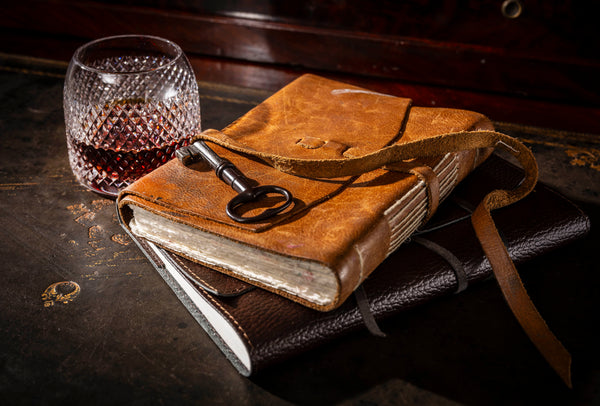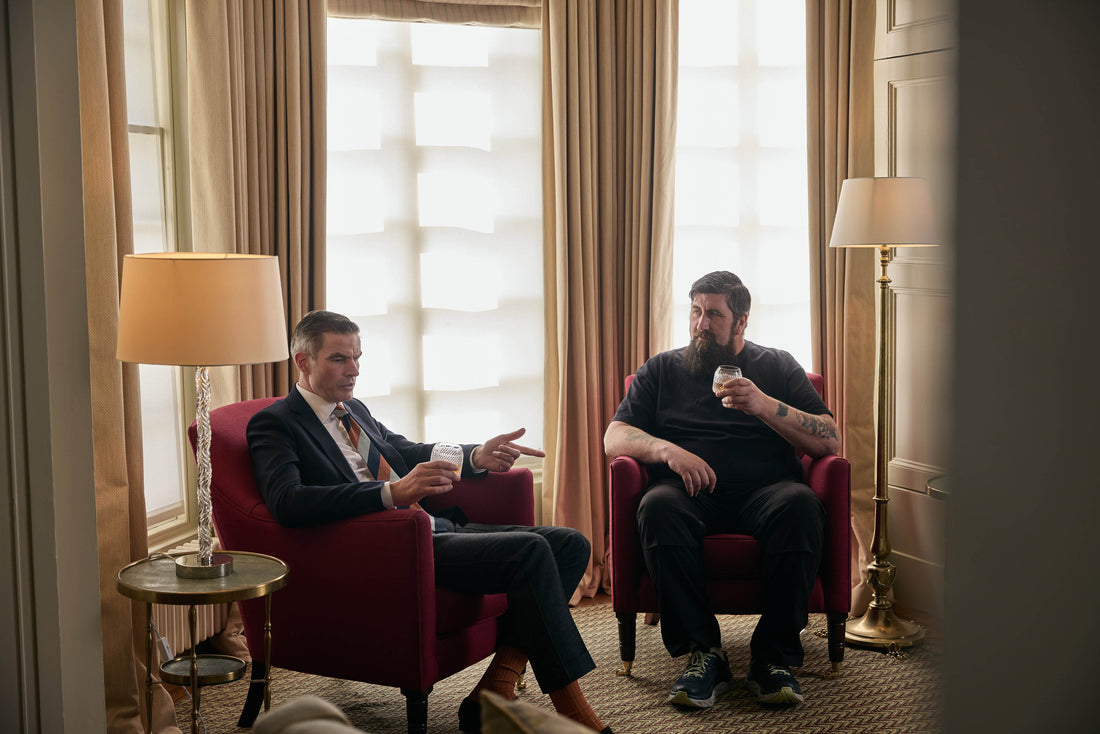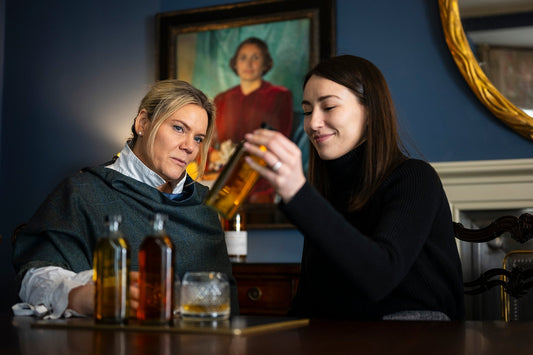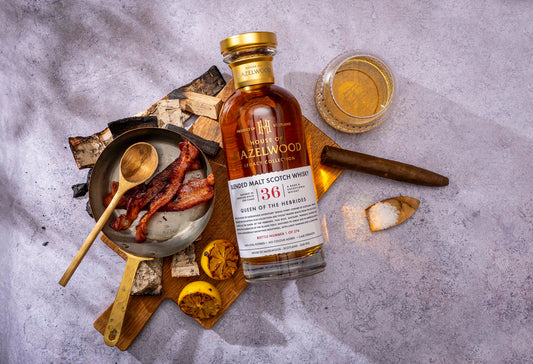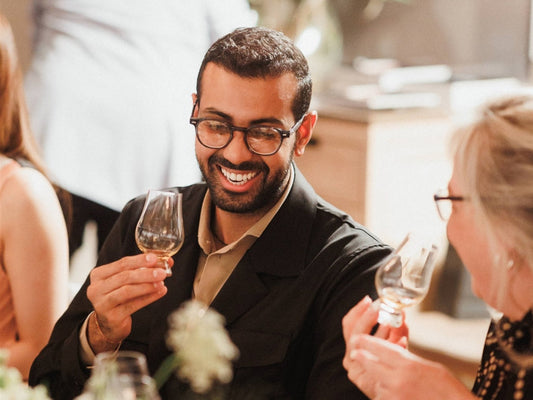Anticipation. Patience. A sense of pride. These are the qualities needed to excel in a discipline of craft, and nobody knows this better than Head Cutter and Creative Director of Huntsman, Campbell Carey.
The parallels that run between tailoring and whisky making are surprisingly similar. Creating an exceptional item – be it a suit or a Scotch – simply cannot be rushed. It requires dedication, attention to detail and a level of expertise that can only come from years of honing a craft. It comes as no surprise that the House of Hazelwood and Huntsman working together in partnership has produced the most exceptional of creations – The Huntsman Blend 50-Year-Old Whisky, in tandem with the bespoke House of Hazelwood tweed – in honour of Huntsman’s 175th anniversary.
We took the opportunity to discuss the milestone collaboration with Campbell Carey, Head Cutter, and Creative Director of Huntsman.

Hi Campbell. Huntsman is celebrating a landmark anniversary next year, but where did it all begin?
Huntsman are 175 years old next year. We were found by Henry Huntsman in 1849, originally setting up shop on Albemarle Street in Mayfair. Today, we’re the standard bearer for bespoke tailoring, not just for Savile Row, but worldwide. We have been granted several royal warrants over the years, bestowed by British and European monarchs, including the Prince of Wales and Queen Victoria.
That is quite a legacy. Can you tell us a bit about your role within Huntsman today?
My job is twofold – I’m the creative director and head cutter. I oversee a team of highly skilled tailors, all bespoke cloth commissions as well as creating our ready-to-wear collections of which we have two per year - for Spring/Summer and Autumn/Winter.

You are very passionate about your craft. You’ve been quoted before saying if you had a different career, you’d be a carpenter! What do you love about it?
For me, it is a discipline. There are no corners to be cut. My career in this industry began with me undertaking a degree at the Scottish College of Textiles, now known as Herriot Watt, located in the Scottish Borders.
After leaving college, I went straight to Savile Row as an apprentice cutter. I remember my then-boss said to me “you can forget all about that degree you’ve got, it’s no use to you here!” So, I did and worked my way up from apprentice cutter to head cutter.
In 2015, I was speaking with Huntsman’s chairman and owner, who said to me “your resume reads more than just head cutter, why don’t you take on the creative director role?” So, I did!
That must have felt like a huge undertaking.
I took the role head on with two hands. All the things I learnt at college were still in the back of my mind. Although after all that time you forget a lot of the technical skills, I specialised in weaving and was able to work with manufacturers throughout the UK and Europe, talking their language to secure the very best product. I’m driven by the pursuit of perfection. Working with the best for materials. Having the best people within a team like we do at Huntsman. It is so inspiring day to day.

What would you say are the characteristics needed to be successful in a craft such as yours?
The main characteristics for a craftsperson, across both tailoring and whisky is to have patience. You can undertake a three-year apprenticeship, be shown what to do, shadow your mentor, but then it comes to a point where you’re on your own and you must go out and risk making mistakes. You learn from these and go forward knowing that you’ll never stop learning. No two body shapes that come in through the door of Huntsman are ever the same, so you’re always learning.
In whisky-making, we have a defined process to follow – from distilling to maturation. What is the process of bespoke tailoring at Huntsman like?
A bespoke suit made by Huntsman will take around 70 hours of hand labour, with approximately 12 experts working on the project. We take up around 30 measurements when a client first comes in to create a paper pattern. The cutter will then use those measurements to cut the cloth and make a garment skeleton, which is then sent to the skilled tailors for the first fit. This is a key fitting as it establishes the foundation of the suit. After this, the suit is ripped down into its component parts and given back to the tailors for the next stage. This stage involves the installation of pockets, lining and facings. The penultimate fitting is all about fine-tuning the suit before it is sent off to be finished and pressed. The paper pattern remains with us, stored securely at Huntsman, a representation of the finished suit, making the process smoother for the client’s subsequent orders.
What do you think the parallels of craft are between whisky making and cutting?
An innate sense of pride. Never becoming complacent. It is also about the anticipation – how a whisky will mature, how it is blended – like with a cloth that I design and create, it is about how it will tailor into a style, into something truly bespoke.
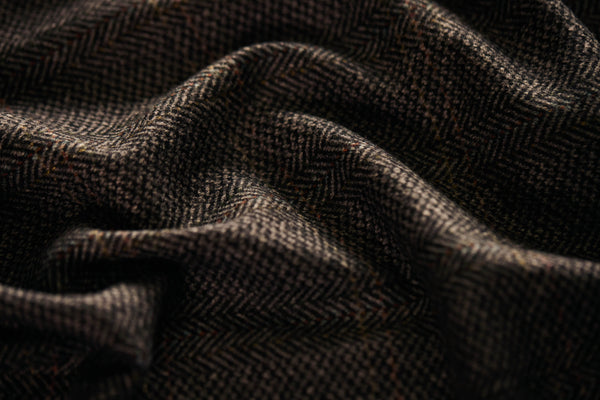
As part of the House of Hazelwood and Huntsman collaboration, you have designed a House of Hazelwood bespoke tweed. Can you tell us about the process behind this?
When designing a cloth, the starting point is the surrounding environment. I visited Hazelwood House, and Speyside a few years ago which served as the basis of my inspiration. In the cloth, you can see the greys of the granite, crafted into a very old design called a Barleycorn with Herringbone weave. The surrounding valley was the inspiration for the accent colours – the purple of the heather, the green of the ferns, the brown of the stone. And of course, the whisky with aquamarine and rust as a nod to the copper oxidisation that can be seen on distillery stills.
Having sampled whiskies from the House of Hazelwood at this point, it became evident quickly that we had to “up our game” with the cloth we were going to create. So, we moved away from a traditional woollen tweed and approached Escorial. Escorial is a rare and noble yarn, hailing from the Spanish royal flock of sheep, dating back to the 1500s. The wool is only available now in very limited quantities and it outperforms cashmere on many levels.
What was the process for blending The Huntsman Blend Scotch Whisky like?
For me, being such a whisky fan myself, and particularly a grain whisky fan, it was music to my ears when I heard about the aged grain that would be part of the samples for the blending panel. The grain was amazing on its own, but in the blend it was incredible. We sampled an extensive range of whiskies, looking at 14 key components. It was a tough job, but somebody had to do it! It was quite the experience for me – something I’ll never forget.
Alongside the whisky, you’ve created a jacket in the House of Hazelwood tweed. Can you tell us more about the jacket?
The jacket itself is a Huntsman house cut. It is a one button silhouette and a nod to the country. It’s a jacket that can be worn in both the country and town. It’s quite a versatile jacket. There is a hipflask [exclusively available with The Huntsman Blend] which is a lovely finishing touch – wrapped in the Escorial cloth.

175 years is quite a legacy to live up to.
Yes, that legacy has to be nurtured. I like to refer to myself as a creative custodian rather than a creative director. Huntsman has been around since 1849 and it’s my job to make sure that legacy is looked after so we’ll go on for another 175 years.
The Huntsman Blend, a 50-Year-Old Blended Scotch Whisky is now available to buy, offered as part of an exclusive gift set, featuring a cloth bound hipflask and two generous 50ml samples to save and savour.
